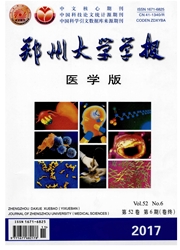

 中文摘要:
中文摘要:
目的:探讨雌激素受体(ER)α基因PvuⅡ多态性与氟暴露地区成人骨组织异常的关系。方法:采用整群抽样方法,在氟病区及对照区选择当地出生或居住5 a以上18~55岁的人群为观察对象;采用PCR-RFLP法分析ERα基因PvuⅡ多态性;采用X线检查两区人群骨组织改变。结果:暴露组和对照组人群骨组织异常率分别为65.34%和40.32%,差异有统计学意义(P〈0.05);以pp基因型为参照,暴露组携带Pp/PP人群骨组织异常的危险性增高(PR=1.087,95%CI=1.053~1.437或PR=1.145,95%CI=1.104~1.318)。结论:携带ERαPvuⅡPp/PP基因型可能增加骨组织对氟暴露敏感性。
 英文摘要:
英文摘要:
Aim:To explore the relationship between estrogen receptor α( ERα) gene polymorphism and bone tissue abnormalities in adults exposed to fluoride in drinking water .Methods:Adults aged from 18 to 55 years old who were born and grew or lived there for at least 5 years in endemic fluorosis villages or control villages were recruited using cluster sam-pling.They were allocated into endemic fluorosis group and control group in accordance with the above areas .PCR-RFLP was used to determine PvuⅡgenotype in ERαgene.X-ray was used to detect changes of the subjects′bone tissue of the two groups.Results:The abnormal rate of bone tissue in endemic fluorosis group (65.34%) were significantly higher than that in control group(40.32%)(P〈0.05).The increased risk of bone tissue abnormalities was observed in subjects carry-ing Pp/PP genotype of ERαgene compared with subjects carrying pp genotype from endemic fluorosis group (PR=1.087, 95%CI=1.053-1.437;PR=1.145,95%CI=1.104-1.318).Conclusion: Bone tissue in people who carried ERαPvuⅡPp/PP genotype may be more susceptible to fluoride exposure .
 同期刊论文项目
同期刊论文项目
 同项目期刊论文
同项目期刊论文
 The association of environmental fluoride, trace elements and urine fluoride in adults living in end
The association of environmental fluoride, trace elements and urine fluoride in adults living in end The Relationship of PTH Bst BI Polymorphism, Calciotropic Hormone Levels, and Dental Fluorosis of Ch
The Relationship of PTH Bst BI Polymorphism, Calciotropic Hormone Levels, and Dental Fluorosis of Ch 期刊信息
期刊信息
